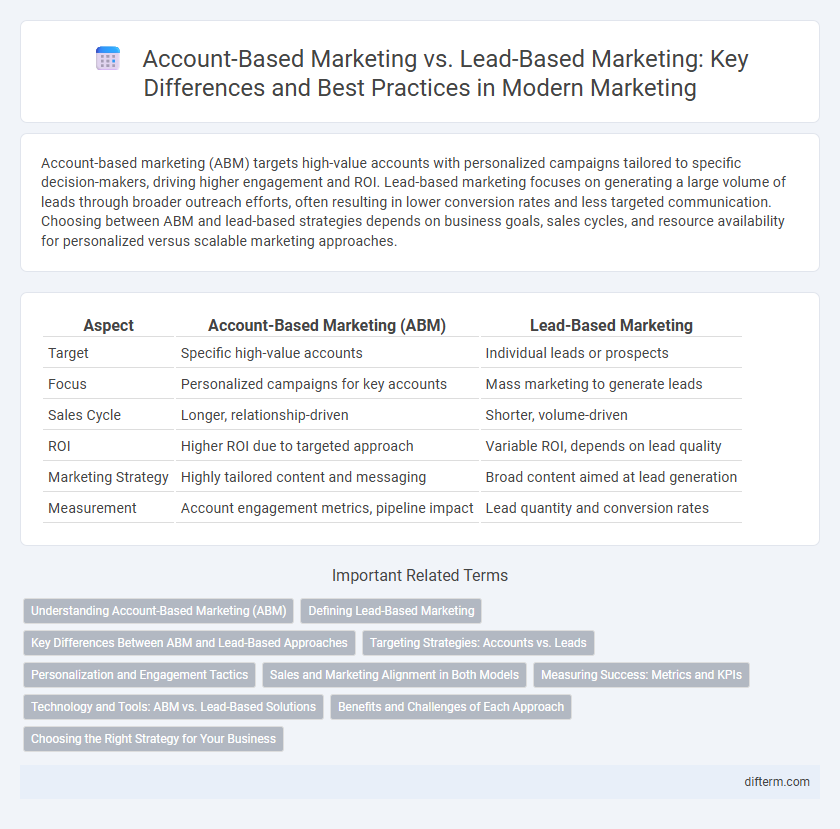Account-based marketing (ABM) targets high-value accounts with personalized campaigns tailored to specific decision-makers, driving higher engagement and ROI. Lead-based marketing focuses on generating a large volume of leads through broader outreach efforts, often resulting in lower conversion rates and less targeted communication. Choosing between ABM and lead-based strategies depends on business goals, sales cycles, and resource availability for personalized versus scalable marketing approaches.
Table of Comparison
| Aspect | Account-Based Marketing (ABM) | Lead-Based Marketing |
|---|---|---|
| Target | Specific high-value accounts | Individual leads or prospects |
| Focus | Personalized campaigns for key accounts | Mass marketing to generate leads |
| Sales Cycle | Longer, relationship-driven | Shorter, volume-driven |
| ROI | Higher ROI due to targeted approach | Variable ROI, depends on lead quality |
| Marketing Strategy | Highly tailored content and messaging | Broad content aimed at lead generation |
| Measurement | Account engagement metrics, pipeline impact | Lead quantity and conversion rates |
Understanding Account-Based Marketing (ABM)
Account-Based Marketing (ABM) targets high-value accounts through personalized campaigns that align sales and marketing efforts, enhancing engagement and conversion rates. Unlike lead-based marketing that focuses on individual prospects, ABM emphasizes strategic account selection, delivering customized content to key decision-makers across multiple departments. This approach drives higher ROI by concentrating resources on accounts most likely to generate significant business growth.
Defining Lead-Based Marketing
Lead-based marketing targets individual prospects by capturing contact information through forms, email sign-ups, or gated content to nurture potential customers over time. This approach relies on generating a high volume of leads to fill the sales funnel and often employs broad campaigns designed to attract interest from a large audience. Key metrics include lead quantity, conversion rates, and cost per lead, making it suitable for businesses seeking rapid pipeline growth across diverse segments.
Key Differences Between ABM and Lead-Based Approaches
Account-based marketing (ABM) targets specific high-value accounts with personalized campaigns, while lead-based marketing casts a wider net aiming to capture and nurture individual leads. ABM aligns sales and marketing efforts to focus on decision-makers within target organizations, boosting ROI and shortening sales cycles. Lead-based marketing relies on volume-driven strategies, generating broader awareness but often with lower engagement and conversion rates compared to ABM's tailored approach.
Targeting Strategies: Accounts vs. Leads
Account-based marketing (ABM) prioritizes targeting high-value accounts by tailoring personalized campaigns to decision-makers within specific organizations, resulting in higher engagement rates and ROI. Lead-based marketing focuses on capturing individual leads through broader tactics such as content marketing and email campaigns, aiming to generate large volumes of prospects. While ABM aligns sales and marketing teams around strategic accounts for long-term growth, lead-based marketing emphasizes quantity and nurturing to build a scalable sales funnel.
Personalization and Engagement Tactics
Account-based marketing (ABM) leverages highly personalized content tailored to specific high-value accounts, increasing relevance and engagement through customized messaging and targeted outreach. Lead-based marketing employs broader segmentation strategies, focusing on attracting large volumes of potential customers with generalized content and automated nurturing campaigns. ABM's precision-driven personalization fosters deeper relationships and higher conversion rates by addressing unique business needs, whereas lead-based marketing emphasizes scale and efficiency.
Sales and Marketing Alignment in Both Models
Account-based marketing (ABM) fosters tighter Sales and Marketing alignment by targeting high-value accounts with personalized campaigns, ensuring both teams collaborate on tailored strategies and shared goals. Lead-based marketing typically segments a broader audience, requiring Sales and Marketing to coordinate on lead qualification and nurturing processes to optimize conversion rates. Effective communication and data sharing between Sales and Marketing are crucial in both models to maximize revenue and customer retention.
Measuring Success: Metrics and KPIs
Account-based marketing (ABM) measures success through metrics like account engagement, deal velocity, and customer lifetime value, emphasizing quality over quantity by targeting high-value accounts. Lead-based marketing focuses on volume metrics such as lead generation rate, cost per lead, and conversion rates to optimize the sales funnel. Comparing KPIs reveals that ABM aligns marketing efforts with revenue growth from key accounts, while lead-based approaches prioritize broad audience reach and lead nurturing efficiency.
Technology and Tools: ABM vs. Lead-Based Solutions
Account-based marketing (ABM) leverages advanced technology platforms such as Demandbase, Terminus, and 6sense to deliver highly personalized campaigns tailored to specific high-value accounts. Lead-based marketing relies on CRM tools like Salesforce and email marketing automation platforms such as HubSpot and Marketo to manage large volumes of leads and nurture prospects. ABM tools emphasize account insights, predictive analytics, and engagement tracking, whereas lead-based solutions prioritize lead scoring, segmentation, and broad outreach capabilities.
Benefits and Challenges of Each Approach
Account-based marketing (ABM) delivers highly personalized campaigns targeting specific high-value accounts, resulting in stronger alignment between sales and marketing, higher ROI, and improved customer retention, but requires significant resources and tight coordination across teams. Lead-based marketing focuses on generating a broad volume of potential customers through scalable strategies like content marketing and email campaigns, offering faster lead acquisition but often leading to lower conversion rates and less tailored messaging. Balancing the benefits of ABM's precision and loyalty with lead-based marketing's reach and speed is essential for creating an effective overall marketing strategy.
Choosing the Right Strategy for Your Business
Account-based marketing (ABM) targets high-value accounts with personalized campaigns, driving higher ROI for B2B businesses seeking quality over quantity. Lead-based marketing casts a wider net to generate a larger volume of potential customers, ideal for companies prioritizing brand awareness and top-of-funnel growth. Selecting the right strategy depends on business goals, sales cycle length, and resource availability, ensuring alignment with company objectives for optimal marketing performance.
account-based marketing vs lead-based marketing Infographic

 difterm.com
difterm.com